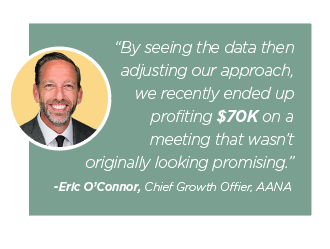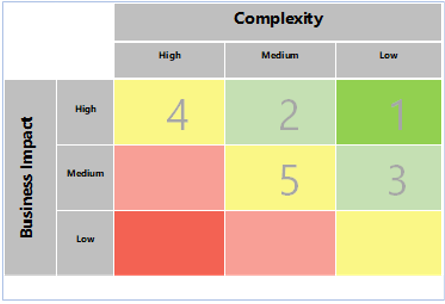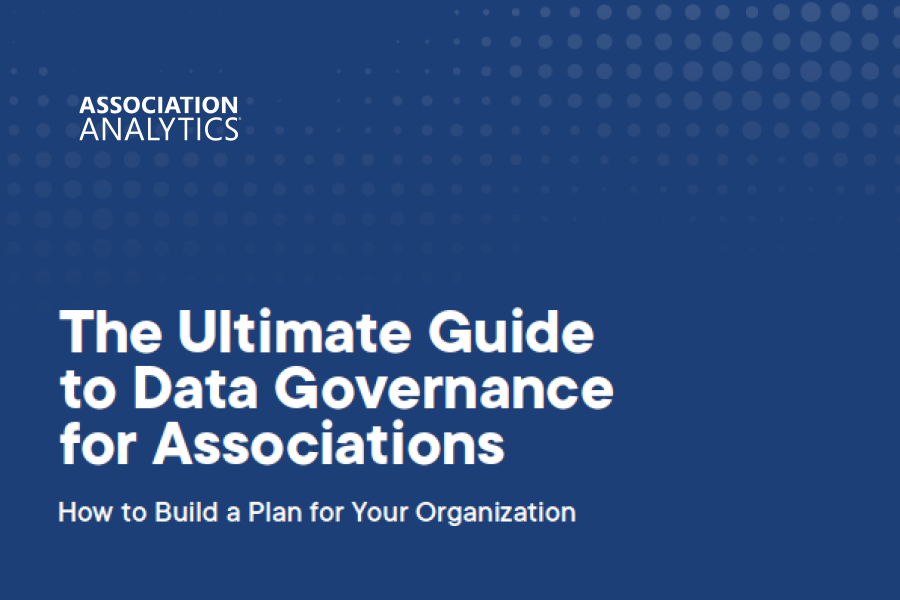It’s a new year with a new start. You probably have a long list of great things you want to accomplish this year…including making analytics a priority. We can help you move analytics to the top of the list by giving you tips to build a business case and how to articulate it to others. This may seem like a daunting task, but it’s easier than you think.
Before we dive in, we want you to start thinking of data as one of your most important assets. Most people don’t. When you ask them what their biggest asset is you commonly hear members or employees. Of course, they are valuable assets, but data is, too. In addition to keeping it safe and secure, think of how you can leverage it to gain insights to help run your association more effectively.
Let’s build your business case to make data analytics a top priority:
1. Start by assessing and documenting the current state of your data
This is not a long process. It should be a quick assessment of your current state. Think about this from the perspective of where you are coming from, where you are now, and what you want to achieve. Ask your colleagues questions. Be sure to ask stakeholders in different departments. We suggest that you have a conversation and not send a survey. Use softer, more open-ended questions to get detailed information that you will capture in writing for your plan. Some examples include:
- Data specific – What data empowers you? What limits you? What do you think about our data? What data do you wish you had? What questions do you want answers to from data?
- Tools – What tools do you have? What tools do you require?
- Process – If you have a question, what is the process to get your answers? An example is how many new members did we acquire last month? Is it at your fingertips? Or do you have to go through a long process to get the answers?
2. Next, define the outcomes you hope to achieve
The outcomes you can achieve tend to fall into four buckets that benefit your organization. These will support your business case by aligning with your goals:
- Consistent, trusted data with standard interactive reports using a common language that employees throughout your organization easily understand – all in a secure data warehouse. This will drive adoption of being a data-driven organization.
- Improved efficiency that will reduce manual work, optimize processes and eliminate redundancy. This will save time and money.
- Revenue growth driven by improved membership numbers, increased product sales and optimized marketing reach and effectiveness. This will help increase membership and revenue.
- Drive strategy by using data to inform your association’s strategy and departmental strategies as well as drive business metrics and KPIs. This will align the organization by having clear success metrics and KPIs.
3. Analyze your short and long-term returns
Analytics is a strategic directive for many associations but there are many short-term returns that present themselves fairly quickly.
Revenue – Seeing data in real-time enables you to maximize your marketing initiatives. For example, if a paid-event registration campaign isn’t on track to meet or exceed your goals, you can adjust your approach mid-course instead of waiting until the campaign has completed and it’s too late to have an impact. See how AANA accomplished this with their first-ever virtual event and ultimately made $70,000 in profit.
- More time – your staff can spend more time on valuable projects rather than creating reports or developing Excel spreadsheets. They can focus on analyzing the data for insights, not pulling all of the data together. Some associations have saved hundreds of hours on report creation per year.
- Fewer mistakes – you will see fewer errors with more accurate data. This will give you more confidence in making data-driven decisions. You’ll also move away from those frustrating situations where you’re looking at reports from different systems that are displaying different values for the same metric. But remember not to get bogged down in too much perfection and let it keep you from getting started. Check out our blog on overcoming your fear of dirty data.
- Marketing research and performance – you’ll be able to segment and target your marketing tactics. By sending messages at the right time to the right people, you’ll see upticks in open and click-through rates because they are receiving relevant content that they care about.
- Culture shift – getting company-wide adoption of anything new can be challenging. However, you should notice early signs right away like the sharing between departments of information that used to be siloed. Read our blog on Creating a Data Culture for Your Association.
Remember, this is a long game. You will see long-term returns that are often less tangible.
- Member engagement – you can identify what products and services your members are interacting with to help increase engagement.
- Loyalty – data can help you understand behavior that drives the most loyalty amongst your members. Armed with these insights, you can take steps to get more of your members up the loyalty curve.
- Lifetime value – you can use data analytics to project the lifetime value (LTV) of members and you can break down the LTV by segments. You can identify which member acquisition strategies drive the highest LTV members, then double down on those.
- Infrastructure stability – with all of your data stored in a data warehouse, it makes switching your other technology platforms easier as you don’t have to be concerned with losing, or not having access to, data from those platforms.
- Strategic alignment – implementing standardized KPI dashboards across your organization helps ensure all of your departments are measuring progress and that their goals ladder up to your organization’s strategic goals.
- Data literacy – as analytics takes hold, everyone in your organization – from the front lines to the Board – will start to talk in common language and have a better understanding of how data impacts the entire organization.
4. Evaluate Your Opportunity Costs
Most associations have a backlog of initiatives they’d like to embark upon. As you decide which priority is the best and what deserves your resources right now, there are many things to consider – strategic alignment, ROI, organizational impact, level of complexity, time to implement, among others. Most important is to use a consistent framework when comparing initiatives. We suggest using:
- Business Impact – what is the return on investment? How many departments will it help? How does it align with the association’s strategies?
- Complexity – how difficult or easy is it to implement and adopt compared to other priorities?
- Cost – be sure to include all hard costs, as well as opportunity costs
5. Communicate to leadership and staff in their language
When advocating for an investment in analytics, be sure to communicate in language that resonates with your audience. This is important because you want to explain data in a way they can understand. Illustrate how data can solve their pain points. For example, instead of asking, “Do you want an Enterprise Data Warehouse?” Ask, “Do you want better member insights to inform strategy?” or “Do you want better productivity?”
Some tips to help you communicate:
- Be clear on assumptions. Lay out your definitions up front. Describe what you plan to improve and outline how you plan to measure it.
- Don’t forget the intangibles. Having modern tools can have an indirect impact on the organization such as helping to retain top talent. It can also help with recruitment as prospective employees want to understand the tools they’ll have to help them do their job.
- Leverage the community. Use testimonials from colleagues at other associations who have benefited from using data and analytics.
- Use case studies & references – use 3rd party examples and case studies as examples of success. Paint a picture that your audience will recognize themselves in.
6. Take action!
Getting started can feel intimidating but it doesn’t have to be. Begin with a phased approach. Some of the key steps can include:
Basic data governance (Check out our Ultimate Guide to Data Governance)
- Identify your most important data elements
- Bring your data together from multiple systems into one place (even a spreadsheet or database to start)
- Start to analyze your data (you can do this with Pivot tables)
- Create some basic visualizations (start with Excel graphs)
More advanced steps include moving your data into a centralized data warehouse and using data analytics platform like Acumen for visualizations and dashboards. Beyond that you can explore predictive analytics and recommendations engines (think Netflix for your members).
By prioritizing data now, you are setting yourself up for some big wins in 2022 and well into the future. The team at Association Analytics is here to help you make data analytics your number one priority. Chat with one of our data-loving experts or watch our recent webinar to help you prioritize data today.






